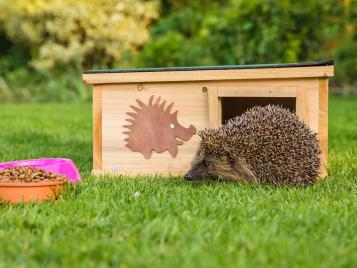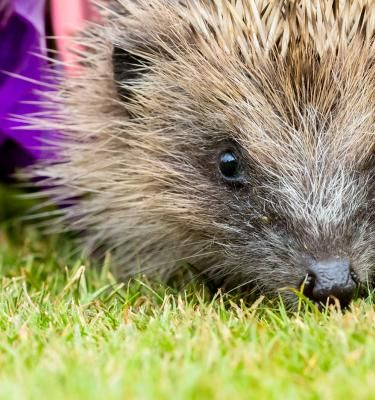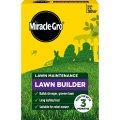Creating hedgehog friendly gardens is easier than you might think and you could have some spiky little garden visitors before you know it.
Known as the gardeners’ friend, hedgehogs have long been appreciated for eating up slugs, snails and insects that aren’t so welcome in our gardens. But in many areas, populations of these fascinating spiny creatures are in decline.
Luckily, there are a few simple steps we can take to make our gardens safe and welcoming again.
Providing the right access
It sounds obvious, but if you want hedgehogs to visit your garden you need to give them a way in. While they can climb some barriers, if your garden is completely surrounded by high brick walls or a wooden fence with an impenetrable gravel board, chances are the little critters won’t be dropping by.
In fact, it’s thought that the prevalence of garden fencing has contributed to the decline in hedgehog numbers. They need to be able to forage for food over large areas to survive, and restricting their movements can make this impossible.
To make hedgehogs welcome, try leaving a small gap under your garden gate or fence. Even if you’re not hoping they’ll set up home on your doorstep, consider opening up a route in and out so that they can cross your garden unhindered.
Giving them shelter
Like humans, hedgehogs need a roof over their head, particularly as hibernation season approaches or when a new litter is due. A variety of purpose-built shelters are available to buy, and these are a great way of encouraging tiny visitors to stick around - but they aren’t essential.

If you are hoping that they’ll use the custom-made home you’ve purchased, it’s a good idea to put it out in plenty of time before hibernation season, so they can get used to it and it’ll start to take on the scent of the outdoors.
Hedgehogs are just as likely to make their own homes anywhere they deem suitable - be it under a shed or indeed a hedge. If you want to make your garden seem like an attractive neighbourhood, make sure prime locations like these aren’t too neat and tidy - they’ll want a supply of twigs and leaves to build their nests.
Safety first
It pays to be vigilant, so check your garden for potential hazards.
Before you disturb your compost heap or light a bonfire, check for signs of prickly inhabitants and go gently with that garden fork.
Hedgehogs enjoy a splash about and need water to drink, but if you have a garden pond it’s essential to make sure you provide an escape route for spiny swimmers.
Another main danger is poison. Avoid slug pellets, which can be mistaken for food and ingested. The good news is that since hedgehogs eat slugs - and many other little garden pests - this will make your garden doubly appealing to them.
What to feed your hedgehog visitors
Well-meaning animal lovers traditionally put a saucer of bread and milk out for wild hedgehogs, but in fact this can be harmful to them.
As a species they are lactose intolerant, which means that milk will make them sick. This can prove very serious, particularly if the animal is already vulnerable. Bread doesn’t contain any of the nutrients they need and is hard to digest, so should also be avoided.
Instead, leave out saucers of fresh water, and sources of food that will nourish without harming. Special hedgehog food is available from some pet stores, but you can also try puppy or kitten food - meat or chicken varieties only, in jelly rather than gravy.
At a push, a little bit of cooked chicken or raw minced meat will do - just make sure it’s cut up into tiny pieces - or even some chopped unsalted nuts.
Most of the time, making your garden hedgehog friendly will be enough to provide a safe environment that will help these fascinating little creatures thrive in the wild. But if you are lucky enough to spot one, it’s worth keeping an eye out for signs that it might be struggling.
As a mainly nocturnal species, if a hedgehog is resting in the sun during the day or seems to be staggering, this is likely to indicate sickness. Likewise, spotting a tiny hedgehog out by itself may be a sign that it’s been orphaned. Tiny hoglets are very vulnerable, particularly when the hibernation period is approaching.
If you spot a hedgehog out during the day or in winter, call your local rescue centre as soon as possible for advice.








